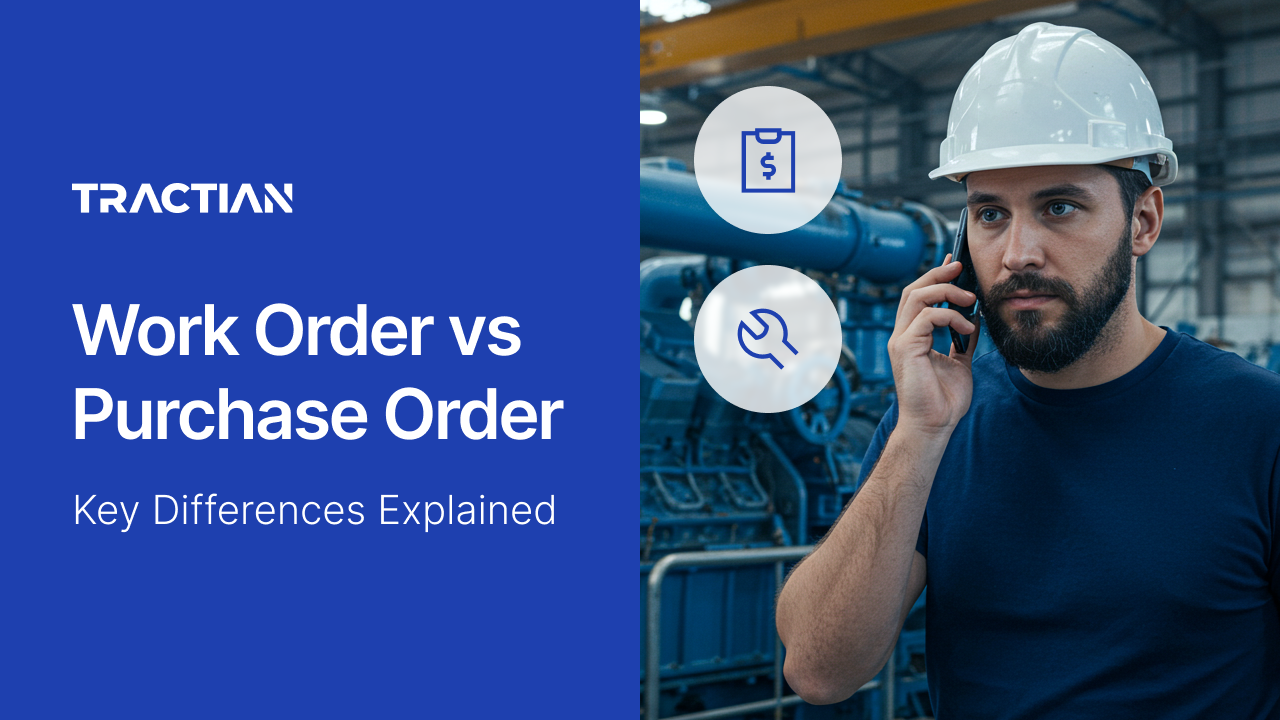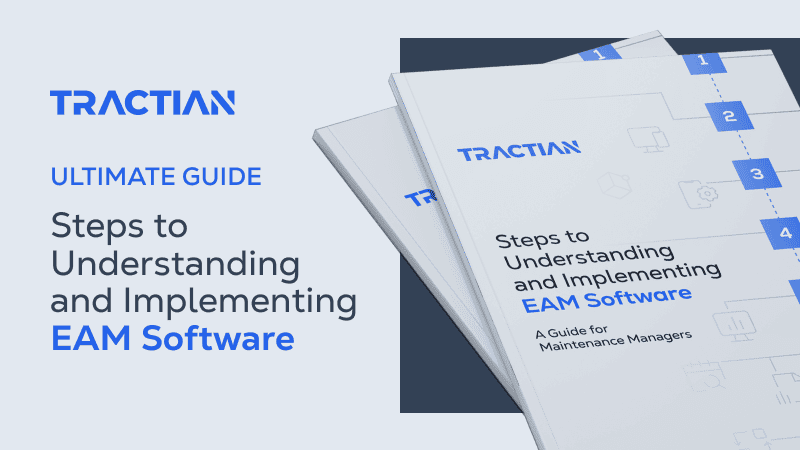When you manage an industrial operation, there’s no room for guesswork. There must be precision and clarity at every turn. Each ordered part, every scheduled task, and every hour logged needs to be traceable.
To accomplish this, work and purchase orders have become two documents fundamental to maintenance and operations teams. They’re staples throughout industrial sectors. That said, they are the two most misused and often lumped together documents in the business.
This would lead you to believe that one must be redundant and unnecessary. But here’s the thing: they're not the same.
That’s why mistaking one for the other isn’t just a fundamental error that creates a little confusion. This error also slows down workflows, disrupts inventory planning, and quietly drains your budget.
Here’s the issue. Work orders and purchase orders each have a very specific function. One keeps your maintenance team moving, and the other ensures your procurement process runs smoothly. One tracks task execution, while the other locks in the transaction between buyers and suppliers.
They have different purposes, different stakeholders, and very different impacts on your operation. Yet, they continue to be used interchangeably, even in highly mature maintenance environments.
In this article, we’ll discuss the key differences-not just in theory but also in the context of daily plant operations.
What is a Work Order?
A work order (WO) is the frontline document of your maintenance operations. Whether it's routine servicing, inspections, repairs, or emergency interventions, a work order defines what needs to be done, by whom, when, and how.
At its core, the work order organizes, tracks, and documents specific tasks or services. It includes essential information like the task description, assigned technician, location of the asset, due dates, and sometimes even the expected downtime or tools required.
It's a task management tool that keeps technicians on target and managers informed about ongoing maintenance work.
Work orders can be generated in response to preventive schedules, condition-based triggers, or operator work requests. No matter how they originate, each work order directly supports your maintenance strategy, enabling teams to stay ahead of failures and optimize asset performance.
A well-managed work order system gives maintenance leaders the data they need to analyze labor costs, downtime trends, and resource allocation. All while creating a future reference log that adds traceability and audit-readiness to the operation.
What is a Purchase Order?
A purchase order (PO) is a legally binding document issued by a buyer to a seller. It outlines the agreed-upon terms for acquiring goods or services - quantities, prices, delivery schedules, and payment terms.
Unlike a work order, which initiates action within your own team, a PO formalizes a transaction between two parties.
This document plays a critical role in the procurement process.
When a maintenance manager or operations team identifies a need - a new motor, replacement parts, or even contracted services - a purchase order is generated to authorize that expenditure.
It includes all the order details required for internal approval and external accountability, such as product or service descriptions, PO number, expected delivery date, and vendor information.
More than just an internal request, the purchase order serves as a contractual agreement. Once accepted by the supplier, both parties are bound by its terms. If incorrect pricing, unclear quantities, or missing specifications exist, they create bottlenecks in the order management flow and can result in delays or disputes.
The contractual nature and contents of a PO highlight why precision and tracking are so important and why it’s a fundamental error to confuse it with or approach it like a work order..
Difference Between Work Order and Purchase Order
The difference from an operational perspective between a WO and a PO is that a work order moves your operation, and a purchase order funds it.
In comparison, both documents function as control mechanisms. Yet, they’re built for entirely different workflows. Confusion between the two in a business often happens because they coexist within the same process. However, their role, destination, and legal weight in that process are very distinct.
Let’s examine them more closely in terms of their intent, authority, execution, and traceability.
Intent: Action vs. Acquisition
A work order is an internal directive that says, "Here’s what needs to be done and by whom." It's focused on tasks, timelines, and asset conditions - not on buying something. On the other hand, a purchase order exists to secure goods or services from a vendor. It defines a financial transaction, not an operational one.
Authority: Task Ownership vs. Budget Ownership
Work orders typically fall under the maintenance team’s jurisdiction. Technicians or supervisors assign, track, and close them.
Purchase orders, however, are routed through procurement or finance. They're approved by people responsible for cost control and supplier agreements. In many cases, WOs and POs don’t speak the same internal language, so clear documentation is essential.
Execution Flow: Internal Progress vs. External Fulfillment
A WO tracks progress across maintenance stages - from scheduling to execution to closeout. It’s dynamic and often changes depending on asset condition or resource availability.
A PO is fixed. Once sent and accepted, it locks in the agreed-upon terms. There's no room for interpretation. The supplier either delivers on time and to spec, or they don't.
Traceability: Operational History vs. Financial Audit Trail
Work orders build an asset’s maintenance history. They show how often a component fails, what tasks were done, how long it took, and what was used. They’re critical for asset reliability tracking.
Purchase orders, on the other hand, build your financial trail. They support budget forecasting, cost center allocations, and vendor performance reviews. When properly structured, they integrate into your ERP system and serve as legal documentation for every dollar spent.
Integration Points
Now that we’ve elaborated on their differences and operational lanes, we can look a where these processes get more interesting. In a well-run plant, these two documents work together collaboratively toward greater efficiency and productivity.
A work order may trigger a purchase order if a required part is out of stock. Similarly, a purchase order can be created independently when procurement is planning for ongoing needs. However, in both situations, the documents must reference each other when linked. This connection ensures transparency across departments.
How to Create a Work Order
Work orders start with a problem or a preventive need and end with documented action. Here’s how to structure that process with clarity and efficiency:
1. Trigger the Request
The process starts with a maintenance need. This can come from scheduled tasks, real-time asset monitoring, or manual work requests submitted by operators or other departments. In some cases, critical equipment alarms or condition-based thresholds may also trigger automatic work order generation.
2. Detail the Task
Once triggered, everything begins to unfold. The work order must outline the task at hand with precision, including details such as:
- A clear description of the problem or service
- Asset or equipment ID
- Task type (inspection, repair, calibration, etc.)
- Specific instructions or safety protocols to follow
3. Assign Technicians and Set Priorities
Next, you’ll designate who’s responsible, define the required skillset, and determine priority levels based on asset criticality or operational impact. This helps avoid overload and ensures the right technician is assigned to the right job.
4. Add Time, Tools, and Materials
Estimating labor hours and logging the necessary tools and spare parts up front helps ensure that the task can be completed without delays. In well-integrated systems, this step also updates inventory levels and availability.
5. Establish Due Dates and Dependencies
Every work order must have a due date and be tied to urgency, production schedules, or regulatory compliance. If the task depends on external services or the arrival of materials, that information should be linked in the order.
6. Track Execution and Close the Loop
As the task is executed, teams log the time spent, parts used, and any changes to the initial scope. Once complete, the WO is closed - but not archived. It becomes part of your asset’s service history and is used for audits, cost analysis, and future planning.
How to Create a Purchase Order
While a work order sets internal action into motion, a purchase order connects your operation with external suppliers. It initiates the procurement process and locks-in the specifics of what you’re buying, under what conditions, and from whom.
Here’s how a purchase order is created step by step:
1. Define the Procurement Need
The process begins when a department identifies the need for goods or services not currently in stock. This could be triggered by a low inventory alert, a project requirement, or a work order that specifies outsourced tasks or parts.
2. Specify the Order Items
At this stage, precision is non-negotiable as a legally binding document is being created. The PO should include:
- Item or service descriptions
- Quantities and units
- Unit prices and total cost estimates
- Supplier identification (name, contact, tax ID)
- Delivery location and shipping terms
3. Assign a PO Number
Each purchase order receives a unique identifier - the PO number - which is essential for tracking across departments, payment systems, and supplier communications.
4. Define Terms and Conditions
This section outlines the agreed-upon prices, payment terms, expected delivery date, return conditions, and warranty information (when applicable). These details are what render the PO a legally binding contract upon acceptance by the supplier.
5. Route for Approval
Most companies have an internal approval workflow based on budget thresholds. Once the PO is reviewed and signed off, it’s ready to be submitted to the vendor. Approval workflows also ensure budget alignment and prevent unauthorized purchases.
6. Send and Monitor the Order
After submission, the PO is officially in the supplier’s hands. From here, the procurement team monitors delivery schedules, validates receipt, and ensures that invoices match the order terms.
Delivery Order vs Purchase Order: Where They Split and Why It Matters
In procurement-heavy operations, the paperwork doesn’t stop once the order is placed. That’s when the next layer begins. And if you’re not clear on what each document represents, things can get messy fast.
While most teams are familiar with purchase orders, delivery orders tend to fly under the radar. But they’re just as important - especially when you're tracking shipments, verifying receipts, or reconciling what was ordered against what actually shows up at your facility.
So, what’s the difference?
Here’s the breakdown:

While the purchase order initiates the transaction - locking in prices, quantities, and delivery terms - the delivery order kicks in at the fulfillment stage. It’s a document created by the seller, not the buyer, and its role is to ensure the correct items are delivered as agreed.
The 4 Types of Purchase Orders And When to Use Each
Not all purchase orders are created equal. Depending on how your operation runs - and how predictable your purchasing cycles are - different types of POs offer different levels of flexibility, control, and commitment.
Here’s what you need to know about the four main types of purchase orders:
1. Standard Purchase Order (PO)
This is the most familiar type of PO. It is used when everything is known and clearly defined. Quantity, price, delivery timeline, supplier, and payment terms are all established upfront.
It's typically for one-time buys or urgent needs, where there's no ambiguity about what's being purchased or when it's required. These orders are transactional and straightforward, and they are the kind of documentation that moves quickly through approval and fulfillment.
2. Planned Purchase Order (PPO)
The planned purchase order is more strategic. It is created when you know what you'll need and from whom, but not the exact delivery dates. You outline the items, quantities, and prices in advance and then issue release orders over time to authorize specific shipments.
This type is useful when demand is predictable but not fixed. It helps you plan for future consumption without overstocking or rushing logistics.
3. Blanket Purchase Order (BPO)
Designed for repetitive purchasing with the same supplier, the blanket PO creates a long-term agreement covering multiple deliveries over time. The difference is that it doesn’t lock in specific quantities or delivery schedules from the outset.
Instead, it simplifies recurring buys - like consumables or indirect materials - under a single reference point. It reduces administrative overhead and often includes negotiated volume pricing or service terms.
4. Contract Purchase Order (CPO)
Unlike the others, the contract PO doesn’t authorize immediate purchases. It’s a foundational agreement that outlines the terms and conditions between the buyer and supplier - price structures, legal obligations, delivery expectations - often over a multi-year period.
Once the contract is in place, individual standard or blanket POs are issued under its umbrella. This framework provides commercial stability while keeping execution flexible.
How Does a CMMS Help With Work Orders and Purchase Orders?
Work Orders and Purchase Orders are the tracks that align maintenance and procurement operations in the industrial environment. One drives task execution, and the other secures the materials and services that make that execution possible.
When WOs and POs are mismanaged, we face delays, inventory mismatches, cost overruns, and missed production targets. But when clearly defined and tightly integrated, each contributes to and streamlines workflows to support smarter, productive decisions across the business.
A CMMS (Computerized Maintenance Management System) makes all the difference in achieving this clarity and integrated alignment. It brings structure, automation, and visibility to everything maintenance teams handle.
For work orders, a CMMS ensures every task is scheduled, assigned, and tracked with real-time data. For purchase orders, it centralizes procurement activity, connects it to asset history, and syncs it with inventory levels. No more silos, no more guesswork.
With the right CMMS in place, work orders can automatically trigger purchase orders when materials are unavailable. Inventory levels update as parts are consumed. Approvals, scheduling, and reporting are all centralized.
And most importantly, teams get time back-time they can spend on strategic maintenance rather than chasing down parts or managing tasks manually.
Tractian’s CMMS solution stands apart in delivering this integrated environment. Built with usability, speed, and industrial workflows in mind, it connects your maintenance, inventory, and procurement processes into one intelligent ecosystem.
From scheduling inspections to tracking parts and identifying purchasing needs, Tractian’s system gives teams full control over the entire work order lifecycle, with clear visibility into related procurement actions.
Bring structure and alignment to your maintenance workflows and clarity to your procurement needs. See how Tractian's CMMS helps your team stay ahead of the competition.



